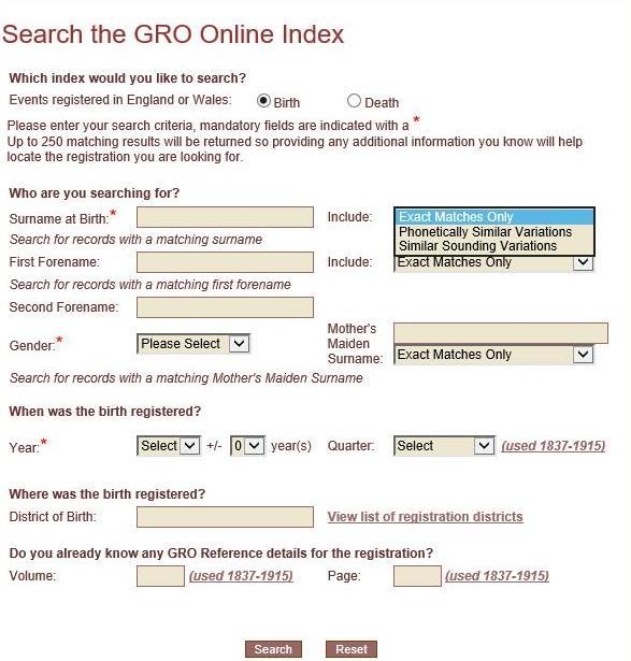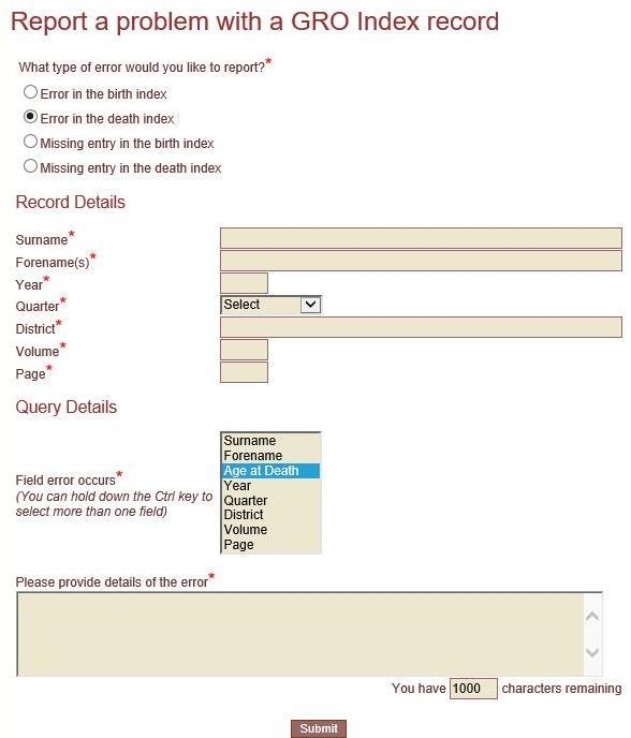Guest Post: The GRO Searchable Database and PDF Pilot
We are happy to welcome Anne from Leaves Family History Research Service as our first Guest Poster. Here, she presents her musings on the new GRO pilot scheme.
Updated 31st January 2018
A Brief Background:
There have been calls to improve access to civil registration records for many years going back at least 25 years. Various Government papers looked at the issues, including a 1990 White Paper on ‘Registration: Proposals for Change’, but little if anything was ever agreed.
In 2002 the 'Civil Registration: Delivering Vital Change', report mentioned electronic access to ‘historic’ records could be provided by a ‘not-for-profit’ organisation. The report may have been referring to FreeBMD, which had started to transcribe a few years before. Between 2005 and 2012 there were several attempts to digitise and index the General Register Office (GRO). records, primarily the DoVE (Digitisation of Vital Events) and MAGPIE (Multi-Access to GRO Public Index of Events) projects, but none were completed. It was not until the Deregulation Act 2015 that different ways of accessing historic civil registration records were discussed again. This Act allows the relevant Government Minister to make regulations dealing with searching and supplying information from civil registration records held in the GRO. (1)
This month (November 2016) the GRO began trialling the first of 3 pilot schemes, allowing the purchase and emailing of PDF copies including birth records dated 1837-1934 and death records dated 1837-1957. The purchase of marriage records are not included in the trial. These copies can only be used for research, not for official identification purposes, as they are not certified. Phase 2 will pilot the delivery of the PDF records within 3 hours, and phase 3 the delivery of PDF copies of civil registration entries that are not held by GRO in a digital format.
The Searchable Index
To assist in the ordering process a free online searchable database was also introduced. To access this you must register and login into the GRO website. Unlike the original GRO indexes, which many family history researchers are familiar with, these indexes include the mother’s maiden name for most birth registrations prior to 1911, and ages of death prior to 1860. Both of these will be a huge boost for researchers. Sadly, the birth index only goes up to 1915, although the death index continues to 1957. This means that in order to purchase a PDF copy of a post 1915 birth record, the reference details must be found on the FreeBMD website or other partner databases. There is currently no searchable GRO index for marriages.
To search either index is easy but also surprisingly restrictive, as can be seen from the image below, and can be accessed via: https://www.gro.gov.uk/gro/content/certificates/indexes_search.asp.

The search for names can be exact spellings, phonetic or similar sounding. The names are also broken down into three parts, surname (which is a requirement), followed by first and second forenames. Although this can be a useful feature there are issues if the person was not known by their 1st forename. It is possible however to search without inputting any forenames, but a surname must always be included.
As the mother’s maiden name can also be added this can making the search for popular surnames easier.
The main issues with this search is that you must choose the gender (male or female, but not both), and a year, but you can only search for up to 2 years on either side.
An interesting omission is that you cannot search the indexes by county. Currently you can either search by registration district, which can be restrictive if the family moved around, or by the whole of England and Wales.
The search page for death registration is similar but includes the age at death (+/- up to 10 years) instead of the mother’s maiden name.
The Search Results
To try this new system, I decided to look for the births and deaths of some of the people in my family tree, and in each case I found all of them, despite some reports of missing entries. In fact, because of the mother’s maiden name search, I found a couple of births that I had not previously found as they had been born and died between census years.
In most cases when I searched for an exact spelling of a surname with no forenames given the results were displayed very quickly, although you have to scroll below the search box to see them. When I requested a phonetic or similar sounding search, it could take up to a minute for the results to be listed, and several seconds to change to the next page. Whether this was because of a long search or because the site was busy I do not know.
My main concern with the results in general, was that the quarters were listed by initial letter. M = March, J=June, S=September and D=December. For experienced researchers this is not too much of a problem, but for new researchers it can be confusing, especially as J could be taken to mean January. There has been some online discussion on various forums about the naming of quarters with some preferring 1st Qtr and 2nd Qtr etc., but my students usually find the JFM, AMJ formats easier to remember.

Another issue with the results is the lack of county. I appreciate that counties moved their boundaries, but I needed to do an internet search to find that the ‘Lexden and Winstree Union’ was in Essex.
An interesting omission in the results shown above is the mother’s maiden name for birth in the Blofield Union. As this child is in my family tree I know he was illegitimate. I searched for other known illegitimate births, where the father is not recorded and in each case the mother’s maiden name column is blank. So this is a good indication of an illegitimate birth.
Early reports of the use of this database suggested that the deaths of infants contained errors relating to their ages. Using known infant deaths from my own family tree I looked up several and only one gave the age as 0 years. In other cases 15 years was shown instead of 15 months, and 1 year instead of 1 day.

The GRO have included a system to correct any incorrect or missing entries, as shown below. The form opens in a new browser window and you are required to complete all of the details yourself. There is no link between the record and the report, unlike the system on the FreeBMD website. Whereas the FreeBMD website entries are linked to the corresponding index page, the GRO entries are not, so possible transcription errors cannot be checked.

Ordering PDF Copies
Ordering PDF copies or the actual certificates is now easy. Once the record has been found in the index search, you simply click on the relevant option, which takes you to the order page where all the information has already been completed - you just need to make the payment.
Conclusion
It seems clear that the new GRO searchable index is simply to help researchers to purchase the correct record, rather than a general research tool. The addition of the mother’s maiden name is very useful, but tempered by the restrictive search of +/- 2 years and the male/female requirement, meaning that several searches for family members must be made rather than one inclusive search. The popular FreeBMD website will, in my view, continue to be a vital resource for the majority of general searches, especially as their double entry system can help to weed out transcription errors.
____________________________________________________________________________
References:
[1] Fairbairn, Catherine. (2015) Briefing Paper. Researching ancestry: access to civil registration records. Number 02722, 9 July 2015. Accessed online : http://researchbriefings.files.parliament.uk/documents/SN02722/SN02722.pdf
____________________________________________________________________________
Update - January 2018
In addition the end date for birth records has been extend by a year to 1916. Each PDF cost £6 compared to £9.25 per Certificate.
Anne Sherman of Leaves Family History is a qualified and experienced Genealogist and Tutor. She can research your family history, help you with your own research or teach you how to start to get started with her online course, using free websites, including the FreeUK Genealogy sites. Anne was a transcriber for FreeBMD and now transcribes for FreeREG.